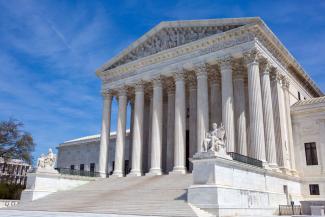OP-ED: Why are we sentencing juveniles to die in prison? The Supreme Court dropped the ball.
By Karl Racine, Miriam Aroni Krinsky, Shay Bilchik
Karl A. Racine is the Attorney General for the District of Columbia
Miriam Aroni Krinsky is the executive director of Fair and Just Prosecution
Shay Bilchik is a research professor and director of the Center for Juvenile Justice Reform at Georgetown University’s McCourt School of Public Policy
Op-ed originally appeared in USA Today
Sometimes the Supreme Court gets it wrong. In the case of Bobby Bostic, the mistake will likely cost him his life in prison.
The court refused to hear the appeal of Bostic, a Missouri man who committed a series of robberies and participated in a kidnapping when he was 16 years old. Bostic, has been in jail for 21 years and will not be eligible for parole until he is 112 years old — effectively a life sentence.
Science has demonstrated that adolescent brains are different from adult brains.
Young people can be more volatile, more susceptible to peer influence, bigger risk takers, and less future-oriented. These factors led the Supreme Court to rule in Graham v. Florida, that the "Constitution prohibits the imposition of a life without parole sentence on a juvenile offender who did not commit homicide.”
Some of the nation’s leading prosecutors weighed in on Bostic's case and urged the court to follow its own precedent.
Even the judge who put Bostic in jail has since called that sentence a mistake and expressed her regret as she publicly urged the court to hear the case. Instead, the court chose to bow out and allow this deeply troubling result to stand.
But the court isn’t the only influential player when it comes to sentencing juveniles. And with anticipated changes to the composition of the Supreme Court, relying on judicial intervention in this area is increasingly uncertain.
Prosecutors must improve juvenile justice
Prosecutors have the authority in their own right to change practice, and reform-minded district attorneys can use their power to ensure decisions like this do not happen again.
Prosecutors are gatekeepers to the justice system. They have significant discretion to decide whether to press charges and what those charges will be, to pursue charges in adult court and seek the maximum penalties or offer a negotiated plea deal. They can advocate for or oppose treatment-based alternatives to incarceration, and they recommend sentence length. Prosecutors can wield influence over how justice is served — with or without the engagement of the Supreme Court.
And the need for reform within juvenile and young adult justice goes far deeper than just abandoning extreme sentences like the one Bostic is serving.
Prosecutors are in the business of relying on evidence. In the realm of juvenile and young adult justice, scientific evidence often challenges practice. Not only do we know that adolescent brains are different, we now know that adolescents and young adults often age out of crime. We know that there is no magical age at which adolescence ends and adulthood begins. For some, the human brain does not mature until the age of 25. We know that confining youth may actually increase their chances of recidivism and that there are more effective alternatives. But most important, we know that adolescence is a window of opportunity — young people are defining their sense of self and the brain experiences its last great window of plasticity. In short, adolescence is a phase in life that is ripe for second chances.
Raise the age
Second chances take many forms. In Washington, D.C., leaders know one of the best ways to get youth out of the justice system is to stop them from entering it at all by helping them stay in school.
For youth who do enter the justice system, prompt holistic treatment interventions, such as D.C.’s ACE Diversion Program (which finds alternatives to incarceration) and Restorative Justice Program (which focuses on repairing harm to victims over prosecution) operated out of the city's attorney general’s office, can help break the cycle of trauma and victimization.
Raising the age at which young people can be tried as adults to at least 18 is another reform prosecutors can champion that reflects scientific reality and can improve not simply the plight of the individual, but also avoid exposing young people to an adult system that's ill equipped to address their needs and more likely to instead put them on a pathway to recidivism.
Vermont has gone even further, becoming the first state in the more than 100-year history of America’s youth courts to enact a law that will ensure that 18- and 19-year olds are prosecuted under juvenile law.
We need to rethink incarceration of young people by developing more youth-centered facilities like D.C.’s New Beginnings Youth Development Center, whose goal is to keep youth out of adult jails and reduce incarceration.
These reforms are not only the fair and just thing to do — they also make financial sense.
It costs about $150,000 a year on average to incarcerate a juvenile in the U.S., and the lifetime cost of a young person’s involvement with the justice system can reach into the millions of dollars. It is both cost-effective and compassionate to invest in healing young people and breaking the cycle of recidivism, rather than locking them up.
The evidence is clear: Children and young adults are different, the justice system must do better, and prosecutors can lead the way.
Even if the Supreme Court is unwilling to engage on cases like that of Bostic, a new generation of prosecutors must work to create a more fair and just future for all young people.

